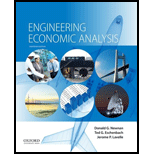
Answer to Problem 11P
27.5% rate of return Bill receives on his investment.
Given information:
In this case, B purchased a vacation lot by making a down payment of $9000 and monthly installment for a period of 40 months which accounts for $500. Since the plot was not as good as assumed by B. Thus he decided to sell the same as a result of which new owner paid $21000 to B against the vacation plot and took over the responsibility to pay for the remaining balance. Therefore, computation of the
Explanation:
In this case, B purchased a vacation lot by making a down payment of $9000 and monthly installment for a period of 40 months which accounts for $500. Since the plot was not as good as assumed by B. Thus he decided to sell the same as a result of which new owner paid $21000 to B against the vacation plot and took over the responsibility to pay for the remaining balance. Therefore, computation of the cash outflow on part of B is shown below:
Thus computation of the
Cash Flow:
IRR =
Conclusion:
27.5% rate of return Bill receives on his investment.
Explanation of Solution
Given information:
In this case, B purchased a vacation lot by making a down payment of $9000 and monthly installment for a period of 40 months which accounts for $500. Since the plot was not as good as assumed by B. Thus he decided to sell the same as a result of which new owner paid $21000 to B against the vacation plot and took over the responsibility to pay for the remaining balance. Therefore, computation of the cash outflow on part of B is shown below.
In this case, B purchased a vacation lot by making a down payment of $9000 and monthly installment for a period of 40 months which accounts for $500. Since the plot was not as good as assumed by B. Thus he decided to sell the same as a result of which new owner paid $21000 to B against the vacation plot and took over the responsibility to pay for the remaining balance. Therefore, computation of the cash outflow on part of B is shown below:
Thus computation of the internal rate of return ascertained by B using the spreadsheet function is shown below:
Cash Flow:
Cash inflow:
IRR =
Conclusion:
27.5% rate of return Bill receives on his investment.
Want to see more full solutions like this?
Chapter 7A Solutions
Engineering Economic Analysis
- 17. Given that C=$700+0.8Y, I=$300, G=$600, what is Y if Y=C+I+G?arrow_forwardUse the Feynman technique throughout. Assume that you’re explaining the answer to someone who doesn’t know the topic at all. Write explanation in paragraphs and if you use currency use USD currency: 10. What is the mechanism or process that allows the expenditure multiplier to “work” in theKeynesian Cross Model? Explain and show both mathematically and graphically. What isthe underpinning assumption for the process to transpire?arrow_forwardUse the Feynman technique throughout. Assume that you’reexplaining the answer to someone who doesn’t know the topic at all. Write it all in paragraphs: 2. Give an overview of the equation of exchange (EoE) as used by Classical Theory. Now,carefully explain each variable in the EoE. What is meant by the “quantity theory of money”and how is it different from or the same as the equation of exchange?arrow_forward
- Zbsbwhjw8272:shbwhahwh Zbsbwhjw8272:shbwhahwh Zbsbwhjw8272:shbwhahwhZbsbwhjw8272:shbwhahwhZbsbwhjw8272:shbwhahwharrow_forwardUse the Feynman technique throughout. Assume that you’re explaining the answer to someone who doesn’t know the topic at all:arrow_forwardUse the Feynman technique throughout. Assume that you’reexplaining the answer to someone who doesn’t know the topic at all: 4. Draw a Keynesian AD curve in P – Y space and list the shift factors that will shift theKeynesian AD curve upward and to the right. Draw a separate Classical AD curve in P – Yspace and list the shift factors that will shift the Classical AD curve upward and to the right.arrow_forward
- Use the Feynman technique throughout. Assume that you’re explaining the answer to someone who doesn’t know the topic at all: 10. What is the mechanism or process that allows the expenditure multiplier to “work” in theKeynesian Cross Model? Explain and show both mathematically and graphically. What isthe underpinning assumption for the process to transpire?arrow_forwardUse the Feynman technique throughout. Assume that you’re explaining the answer to someone who doesn’t know the topic at all: 15. How is the Keynesian expenditure multiplier implicit in the Keynesian version of the AD/ASmodel? Explain and show mathematically. (note: this is a tough one)arrow_forwardUse the Feynman technique throughout. Assume that you’re explaining the answer to someone who doesn’t know the topic at all: 13. What would happen to the net exports function in Europe and the US respectively if thedemand for dollars rises worldwide? Explain why.arrow_forward

 Principles of Economics (12th Edition)EconomicsISBN:9780134078779Author:Karl E. Case, Ray C. Fair, Sharon E. OsterPublisher:PEARSON
Principles of Economics (12th Edition)EconomicsISBN:9780134078779Author:Karl E. Case, Ray C. Fair, Sharon E. OsterPublisher:PEARSON Engineering Economy (17th Edition)EconomicsISBN:9780134870069Author:William G. Sullivan, Elin M. Wicks, C. Patrick KoellingPublisher:PEARSON
Engineering Economy (17th Edition)EconomicsISBN:9780134870069Author:William G. Sullivan, Elin M. Wicks, C. Patrick KoellingPublisher:PEARSON Principles of Economics (MindTap Course List)EconomicsISBN:9781305585126Author:N. Gregory MankiwPublisher:Cengage Learning
Principles of Economics (MindTap Course List)EconomicsISBN:9781305585126Author:N. Gregory MankiwPublisher:Cengage Learning Managerial Economics: A Problem Solving ApproachEconomicsISBN:9781337106665Author:Luke M. Froeb, Brian T. McCann, Michael R. Ward, Mike ShorPublisher:Cengage Learning
Managerial Economics: A Problem Solving ApproachEconomicsISBN:9781337106665Author:Luke M. Froeb, Brian T. McCann, Michael R. Ward, Mike ShorPublisher:Cengage Learning Managerial Economics & Business Strategy (Mcgraw-...EconomicsISBN:9781259290619Author:Michael Baye, Jeff PrincePublisher:McGraw-Hill Education
Managerial Economics & Business Strategy (Mcgraw-...EconomicsISBN:9781259290619Author:Michael Baye, Jeff PrincePublisher:McGraw-Hill Education





